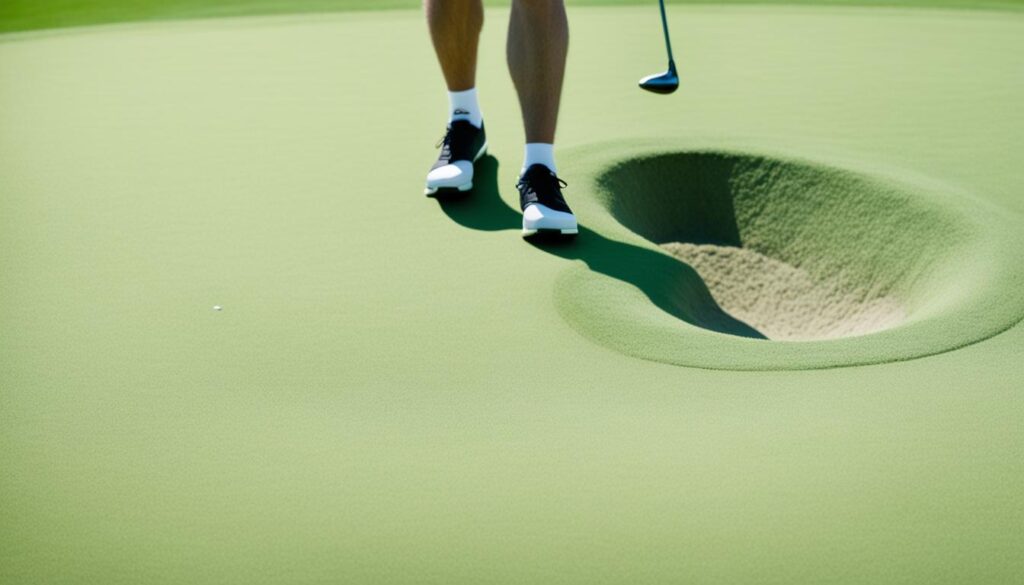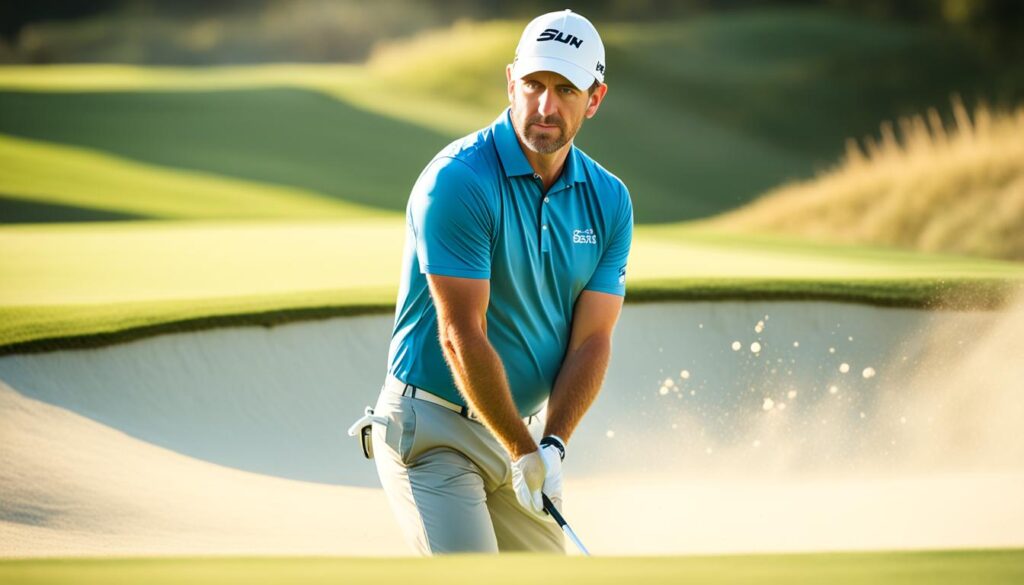Golfers face various challenges on the course, and one of the most intimidating obstacles is navigating different sand conditions in bunkers. Whether encountering fluffy sand or firm, packed sand, mastering bunker shots requires a combination of skill, technique, and confidence. In this guide, we will provide you with practical tips to help you tackle both types of sand bunker shots with confidence, improving your overall performance on the course.
Are you ready to conquer those intimidating sand traps and take your game to the next level? Let’s dive into the world of bunker shot techniques and explore the adjustments needed in setup and swing for each type of sand condition.
Key Takeaways:
- Proper setup adjustments are crucial for different sand conditions, such as opening the clubface for fluffy sand and keeping it more neutral for firm, packed sand.
- Modifying your swing based on the specific sand conditions is vital, with a full swing recommended for fluffy sand and a controlled, less aggressive swing advised for firm sand.
- Prioritize pre-shot preparation when facing fairway bunkers, including assessing the sand conditions, selecting the right club, establishing the ideal stance, and maintaining focus and confidence.
- Consistent practice and refinement of skills will lead to greater proficiency in bunker shots and overall improvement in your sand play.
- Remember to troubleshoot bunker shots and adjust your technique accordingly, ensuring adaptability in different scenarios.
Adjusting Your Setup for Fluffy Sand
When facing a bunker shot in fluffy sand, it’s important to modify your setup. Positioning the ball slightly forward in your stance and opening the clubface will allow for a higher, softer shot that takes advantage of the sand’s resistance. A full swing can be confidently made, knowing that the sand will limit the distance the ball travels.
Fluffy sand in bunkers presents a unique challenge for golfers, requiring adjustments to the setup to ensure successful execution. To achieve the desired trajectory and distance control, follow these steps:
- Position the ball slightly forward in your stance: This adjustment helps ensure that the club enters the sand before making contact with the ball, resulting in a clean strike. It also promotes a higher ball flight, enabling the shot to clear the bunker’s lip.
- Open the clubface: By rotating the clubface to the right (for right-handed golfers), you increase the club’s effective loft. This loft helps generate the necessary height and softness in the shot. It’s important not to exaggerate the clubface opening, as it may cause accuracy issues.
- Visualize the shot: Before taking your swing, visualize the trajectory you want to achieve. Focus on hitting approximately two inches behind the ball to ensure a clean contact with the sand and allow the sand’s resistance to help loft the ball out of the bunker.
| Setup Adjustment | Key Points |
|---|---|
| Ball Position | Position the ball slightly forward in your stance, approximately off the left instep (for right-handed golfers). |
| Clubface | Open the clubface by rotating it to the right (for right-handed golfers) to increase effective loft. |
| Visualization | Imagine hitting approximately two inches behind the ball and focus on a high, soft trajectory. |
By making these adjustments to your setup and approach, you’ll be better equipped to handle fluffy sand in bunkers and execute successful shots. Practice and experimentation will further refine your ability to adapt to varying bunker conditions and enhance your overall performance.
Adapting Your Setup for Firm, Packed Sand
Golfers face different challenges when playing bunker shots from firm, packed sand. In order to successfully navigate this type of sand trap, adjustments to the setup are crucial. By modifying your setup, you can avoid digging too deep into the sand and generate a lower, more penetrating shot.
When faced with firm, packed sand in a bunker, it’s important to make the following modifications:
- The ball should not be positioned as far forward in the stance as it would be in fluffy sand. Placing the ball a bit more centered in your stance will help you avoid digging too deeply into the sand. This adjustment allows for a cleaner strike and helps promote a more controlled shot.
- The clubface should be kept more neutral. Unlike in fluffy sand where opening the clubface is recommended, keeping the clubface square to slightly closed will prevent the club from bouncing off the hard sand too much. This promotes better contact and enables a lower trajectory.
By adapting your setup for firm, packed sand, you’ll be able to execute bunker shots more effectively and confidently. This modification allows for improved control over the ball’s trajectory and helps to maximize your chances of successfully escaping the sand trap.
Remember, practice is key to mastering bunker shots from different sand conditions. By refining your setup adjustments for firm, packed sand, you’ll be able to improve your bunker play and ultimately lower your scores.

Modifying Your Swing for Different Sand Conditions
In addition to adjusting the setup, the swing plays a crucial role in successfully navigating different sand conditions in bunker shots. Understanding how to modify your swing based on the specific sand conditions will greatly enhance your ability to execute precise shots and achieve optimal outcomes.
When faced with fluffy sand, a full swing is often the ideal approach. The sand’s resistance will provide the necessary power to propel the ball out of the bunker while still maintaining control. By confidently taking a full swing, you can generate enough momentum to lift the ball effortlessly, allowing it to land softly on the green.
On the other hand, firm sand requires a more controlled and less aggressive swing. By adopting a more subdued approach, you can ensure optimal trajectory and distance control. It is important to avoid digging too deep into the packed sand, as this can result in the ball flying too low and potentially rolling further than desired.
The Key Swing Adjustments for Different Sand Conditions:
- Fluffy Sand: Opt for a full swing to take advantage of the sand’s resistance and generate the necessary power. This will help achieve a higher, softer shot.
- Firm Sand: Employ a controlled and less aggressive swing to maintain optimal trajectory and distance control. This will allow for a lower, more penetrating shot.
By adapting your swing technique to the specific sand conditions, you can improve your chances of successfully escaping from bunkers and achieving more consistent results.
Remember, practice and experimentation are crucial in refining your swing adjustments for different sand conditions. Take the time to familiarize yourself with the intricacies of each type of sand and how they affect your shots. With persistence and the right technique, you can conquer sand traps and elevate your overall performance on the golf course.
Pre-Shot Preparation for Golf Sand Traps
Properly hitting out of fairway bunkers requires meticulous pre-shot preparation. To excel in fairway bunker shots, it is crucial to assess the sand conditions, select the right club, establish the ideal stance, and maintain focus and confidence.
- Assessing the sand conditions: Before taking a shot from a fairway bunker, it’s essential to evaluate the sand’s texture, depth, and firmness. This information will help you determine the necessary adjustments to your setup and swing.
- Selecting the right club: The fairway bunker’s distance to the target and the length of the shot required will influence your club selection. Typically, a higher lofted club, such as a sand wedge or lob wedge, is recommended to help maximize height and control.
- Establishing the ideal stance: In a fairway bunker, it’s important to maintain a stable base and avoid digging the club into the sand. To achieve this, position your feet slightly wider than shoulder-width apart and keep the weight evenly distributed.
- Maintaining focus and confidence: Fairway bunker shots can be mentally challenging, as the fear of hitting the ball fat or thin may creep in. Stay focused on the fundamentals, trust your swing, and commit to the shot with confidence. Visualize the desired outcome and execute with conviction.
By following these pre-shot preparation techniques, you will enhance your fairway bunker play and increase your chances of success. Remember to practice these skills regularly to build confidence and consistency in your game.
Quote:
“Preparation is the key to success in fairway bunkers. By assessing the sand conditions, choosing the right club, establishing a solid stance, and maintaining focus, you can approach these shots with confidence and improve your overall performance on the course.”
Now that we understand the importance of pre-shot preparation for fairway bunker shots, let’s take a look at some practical examples:
| Sand Condition | Club Selection | Stance |
|---|---|---|
| Soft, fluffy sand | Sand wedge or lob wedge | Wider stance with even weight distribution |
| Firm, packed sand | Gap wedge or pitching wedge | Slightly narrower stance with even weight distribution |

Conclusion
Mastering bunker shots in both soft and hard sand conditions is crucial for improving your overall performance on the golf course. By understanding and implementing the right techniques, you can confidently navigate sand traps and enhance your game.
Adjusting your setup and swing is key to bunker shot mastery. In fluffy sand, position the ball slightly forward in your stance and open the clubface to achieve a higher, softer shot. On the other hand, in firm, packed sand, keep the ball less forward in your stance and maintain a more neutral clubface for lower, penetrating shots.
To continuously improve your sand play, consistent practice is essential. Regularly refining your skills and dedicating time to troubleshoot bunker shots will lead to greater proficiency. By mastering bunker shots, you will elevate your performance and reach a higher level of play on the golf course.
Remember, improving sand play is a process that requires patience and perseverance. By putting in the effort to develop your bunker shot skills, you will gain the confidence needed to conquer any sand trap you encounter. So keep practicing and watch your bunker play transform!
FAQ
What adjustments should I make for a fluffy sand bunker shot?
When facing a bunker shot in fluffy sand, position the ball slightly forward in your stance and open the clubface. This setup will allow for a higher, softer shot that takes advantage of the sand’s resistance. Make a full swing, knowing that the sand will limit the distance the ball travels.
How should I modify my setup for a firm, packed sand bunker shot?
To play a bunker shot from firm, packed sand, adjust your setup by not positioning the ball as far forward in your stance and keeping the clubface more neutral. These modifications will help avoid digging too deep into the sand and generate a lower, more penetrating shot.
How should I modify my swing for different sand conditions in bunkers?
For fluffy sand, a full swing is suitable as the sand’s resistance provides the right amount of power. In contrast, a controlled, less aggressive swing is advised for firm sand, allowing for optimal trajectory and distance control.
What should I focus on in pre-shot preparation for fairway bunker shots?
Properly hitting out of fairway bunkers requires meticulous pre-shot preparation. Assess the sand conditions, select the right club, establish an ideal stance, and maintain focus and confidence. These steps will provide a systematic approach to excel in fairway bunker shots.
How can I improve my overall performance in sand traps?
By mastering bunker shots in both soft and hard sand conditions and making adjustments to your setup and swing, you can confidently navigate sand traps and enhance your performance on the course. Consistent practice, refining your skills, and troubleshooting bunker shots will lead to greater proficiency and a higher level of play.



